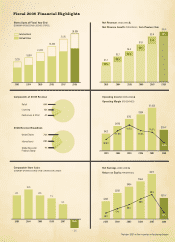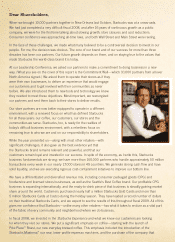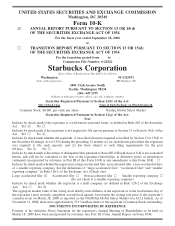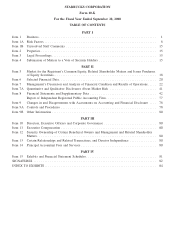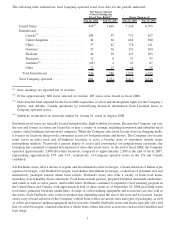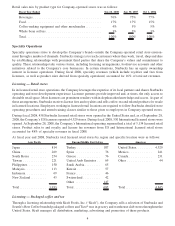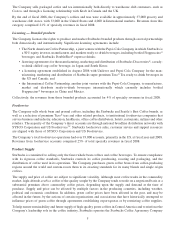Starbucks 2008 Annual Report Download - page 12
Download and view the complete annual report
Please find page 12 of the 2008 Starbucks annual report below. You can navigate through the pages in the report by either clicking on the pages listed below, or by using the keyword search tool below to find specific information within the annual report.S.R.L., a wholly owned subsidiary located in Costa Rica. Staffed with agronomists and sustainability experts, this
first-of-its-kind Farmer Support Center is designed to proactively respond to changes in coffee producing countries
that impact farmers and the supply of green coffee. During fiscal 2008, the Company expanded this sustainability
program to Africa by establishing a Farmer Support Center in Rwanda.
The Company buys coffee using fixed-price and price-to-be-fixed purchase commitments, depending on market
conditions, to secure an adequate supply of quality green coffee. Due to volatility in green coffee commodity prices,
the Company has historically used fixed-price purchase contracts in order to bring greater certainty to its cost of
sales in future periods and promote sustainability by paying an equitable price to coffee producers. When green
coffee commodity prices are high for sustained periods of time, the Company is less likely to enter into fixed-price
contracts on favorable terms and more likely to increase the use of price-to-be-fixed contracts to meet its demand for
coffee. These types of contracts state the quality, quantity and delivery periods and fix the price relative to a green
coffee commodity benchmark, but allow the benchmark price to be established after contract signing. An increased
use of price-to-be-fixed contracts instead of fixed-price contracts decreases the predictability of coffee costs in
future periods until the price of green coffee becomes “fixed” by either Starbucks or the seller.
During fiscal 2008 Starbucks more than doubled its volume of price-to-be-fixed purchase commitments when
compared to fiscal 2007, as a result of higher green coffee commodity prices. During fiscal 2008, “C” coffee
commodity prices traded on the New York Board of Trade within a price range of $1.18 to $1.67 per pound and
prices were, on average, approximately 20% higher than fiscal 2007 and 25% higher than fiscal 2006.
As of September 28, 2008, the Company had $583 million of purchase commitments which, together with existing
inventory, is expected to provide an adequate supply of green coffee through calendar 2009. Based on expected
coffee delivery dates, approximately 86%, 9% and 5% of these purchase commitments will be received by
Starbucks in fiscal years 2009, 2010 and 2011 and later, respectively. Additionally, approximately $246 million of
these purchase commitments are price-to-be-fixed contracts, most of which will be received by Starbucks during
fiscal 2009.
The Company depends upon its relationships with coffee producers, outside trading companies and exporters for its
supply of green coffee. The Company believes, based on relationships established with its suppliers, the risk of non-
delivery on such purchase commitments is remote.
In addition to coffee, the Company also purchases significant amounts of dairy products, particularly fluid milk, to
support the needs of its Company-operated retail stores. Dairy expense for the US segment represents a large
majority of the Company’s total dairy expense; therefore significant changes in US dairy prices can have a material
impact on total dairy expense. The US segment’s dairy costs, which closely follow the monthly Class I fluid milk
base price as calculated by the US Department of Agriculture, can change significantly in the short term. The
Company’s US dairy costs remained higher throughout most of fiscal 2008 compared to fiscal 2007, adversely
affecting the US segment’s and the Company’s profitability. In the United States, the Company purchases
substantially all of its fluid milk requirements from three dairy suppliers. The Company believes, based on
relationships established with these suppliers, that the risk of non-delivery of enough fluid milk to support its US
retail business is remote.
The Company also purchases a broad range of paper and plastic products, such as cups, lids, cutlery, napkins,
straws, shopping bags and corrugated paper boxes from several companies to support the needs of its retail stores as
well as its manufacturing and distribution operations. The cost of these materials is dependent in part upon
commodity paper and plastic resin costs, but the Company believes it mitigates the effect of short-term raw material
price fluctuations through strategic relationships with key suppliers.
Products other than whole bean coffees and coffee beverages sold in Starbucks retail stores are obtained through a
number of different channels. Beverage ingredients, other than coffee and milk, including leaf teas and the
Company’s selection of ready-to-drink beverages, are purchased from several specialty manufacturers, usually
under long-term supply contracts. Food products, such as fresh pastries, breakfast sandwiches and lunch items, are
generally purchased from both regional and local sources. Coffee-making equipment, such as drip and coffee press
coffeemakers, espresso machines and coffee grinders, are generally purchased directly from their manufacturers.
6


